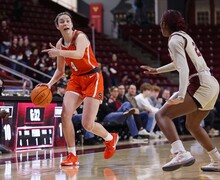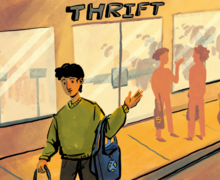How Syracuse’s newest threat, the tight end, strengthens the offense
Todd Michalek | Staff Photographer
Ravian Pierce is third on SU in receiving yards per game, trailing only Ervin Philips and Steve Ishmael.
Dino Babers sees Syracuse’s tight end usage akin to a basketball scheme. On the hardwood, one player’s job is to set screens for a teammate to shoot 3-pointers. Babers’ tight ends are supposed to be no different, because their role is to draw a bigger linebacker or smaller defensive back, which could open up space or create mismatches for slot and outside receivers. Just like a pick-setter clears room for a shooter.
“And based off what (the defense) does,” Babers said, “you decide whether you want to run the ball or throw the ball based on your advantage.”
Syracuse has not only created more advantages with junior tight end Ravian Pierce, but it has capitalized on many of them. Through the tight end, Syracuse (4-5, 2-3 Atlantic Coast) is running an offense that hasn’t existed here in five years. The SU coaching staff wanted to expand the responsibility of its tight end after last year, Babers said, when Syracuse tight ends pulled in six catches for 49 yards total. Pierce has about four times that total with three games remaining on the schedule.
It is Pierce, a junior college transfer and four-star recruit, who has brought the tight end position at Syracuse back into vogue. There has been no tight end production similar to Pierce since 2012, when Beckett Wales’ 35 catches ranked second on the Syracuse single-season receptions list for the position. Through nine games, Pierce is up to 24 catches for 204 yards and a pair of touchdowns. He averages 22.7 receiving yards per game, behind only Ervin Philips and Steve Ishmael.
“They think ‘run’ and forget about me,” Pierce said. “Just putting the defense in a bind. They have to pick to run or guard me. This offense is pretty unique.”
Over the last three years at Syracuse and Bowling Green, Babers’ starting tight ends averaged 8.3 catches, 51 yards and one touchdown per year. The bottom line is Babers-led offenses historically have not used tight ends. Neither has SU, yet this year Syracuse’s tight end usage is at its highest level in five years. It’s contrary to a larger theme across the college football landscape, as more emphasis is placed on receivers.

Andy Mendes | Digital Design Editor
Hurry-up offenses in which receivers are spread out wide tend to minimize the role of the tight end. Players said football teams at every level, from high school to college to the pros, are finding that their offense runs more effectively with receivers.
While tight end usage is up in the Big Ten, per the Associated Press, the proliferation of spread and no-huddle offenses has dimmed the spotlight on tight ends in college. As a result, NFL teams are more selective when drafting college TEs.
That’s mostly because tight ends typically fall under one category: They’re seen primarily as blockers, without the speed to pose as a receiving threat. Or they’re receivers down field but not strong or reliable enough to block regularly.
“It’s one of the toughest positions there is in football,” said Louisville head coach Bobby Petrino, “because you have to run block, you have to pass block, and you’ve got to run routes and catch the ball and run after the route.”
Pierce does both. At 6-foot-3 and 237 pounds, he possesses a combination of size and decent speed. He is part of both the run and pass game, especially when junior quarterback Eric Dungey breaks loose with his legs. Pierce has benefited from one-on-one mismatches against either smaller defensive backs or slower linebackers, and he benefits from the extra attention teams put on Ishmael and Philips, Babers said.
Pierce also is a quality run blocker, said Florida State’s Jimbo Fisher, whose Seminoles held him to one catch and zero receiving yards in a 27-24 win last week. Typically, SU operates power runs with Pierce as the anchor. He also can be flexed out wide, where he creates jailbreak screens for outside receivers.
“You have to be aware of him,” Fisher said. “Then you’ve got those wideouts and they’re throwing it so fast. And then the quarterback can run, and they’re running the football. It makes it tough, and he is another weapon.”
SU didn’t have a consistent tight end presence during Scott Shafer’s option-based system, and SU hasn’t had a tight end like this since the Doug Marrone era. Attacking defenses with a bigger body can be effective in the red zone, where Syracuse ranks among the top 40 red-zone offenses in the country. In the grand scheme of the offense, it provides Dungey an option not named Ishmael or Philips.
“That’s a big schematical advantage that we have against other teams,” Dungey said.
Ishmael, who ranks sixth in the country with 986 receiving yards, credited Pierce’s presence as one reason his own production has soared. Ishmael said Pierce is taking away opposing safeties. He added that he has seen “a lot more” one-on-one coverages this year because they are paying special attention to Pierce inside. Safeties shift over to watch Pierce, which tends to open up space for others.

Andy Mendes | Digital Design Editor
The benefits extend to even the offensive line, where senior right tackle Jamar McGloster noticed Pierce’s impact. For the first time in McGloster’s career, there is a consistent, strong tight end who can help block defensive ends on runs. Pierce’s specialty, McGloster said, is the pancake block, which leaves a defensive player flat on his back as the running back exploits the hole.
“Defenders don’t know if he’s going to block them or fake and release,” McGloster said. “He’s a big threat, helping the O-line and Dungey a ton.”
Syracuse’s tight end usage shows no signs of slowing down, because Pierce still has the remainder of this season plus next year ahead of him. Babers said he wants to add bigger, more flexible tight ends in years to come.
Back in February, Babers’ first commitment from the Class of 2018 was Gabe Horan, who brings the size (6-foot-6, 260 pounds) of an offensive lineman out of nearby Baker (New York) High School. His position: tight end.
“When we’re really rocking and rollin’,” Babers said, “we’re 11 in what we call 21 personnel. That’s one tight end on the field, one tailback, or two running backs on the field, one tight end. I don’t like taking a tight end off the field … We love tight ends.”
Published on November 9, 2017 at 9:19 pm
Contact Matthew: mguti100@syr.edu | @MatthewGut21





